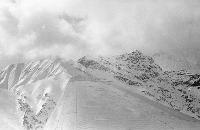Фотографии
-
Регистрационный номер: AP-AMC One of PIAs first Boeing 720s, AP-AMC, photographed by John at Rawalpindi before his DC-3 flight to Chitral.
Самолёты на фотографии: Boeing Boeing 707/720 - США - 1954
-
Регистрационный номер: AJ-APT The arrival of Douglas C-47B AJ-APT causes a sensation among the locals at the remote airstrip at Chitral on February 18, 1962. The aircraft was built at Douglas’s Oklahoma City factory with the USAAF serial 43-49607, but was delivered to the RAF in December 1944 to serve as Dakota IV KK177 in India with Nos 194 and 76 Sqns. It remained in India after the war, becoming AP-AEI with Orient Airways in 1949 before being transferred to PIA in March 1955 to become AP-AJT and named City of Rawalpindi.
Самолёты на фотографии: Douglas DC-3 / C-47 Skytrain/С-53 Skytrooper / Dakota - США - 1935
-
Регистрационный номер: AP-AJT The 20th Century meets the Middle Ages - the DC-3 is inspected by the local population at Chitral. Reportedly, the aircraft’s registration had been changed from AP-AEI to AP-AJT as the “I” in the former would have meant referring to it with the phonetic-alphabet word “India”, which the Pakistani authorities deemed unacceptable, relations between the two nations being very poor. The DC-3 ultimately went to Air Taxi of Iran as EP-AGZ in 1968 but was written off in a non-fatal take-off accident at Ahwaz in southern Iran in April 1970.
Самолёты на фотографии: Douglas DC-3 / C-47 Skytrain/С-53 Skytrooper / Dakota - США - 1935
-
Chitralis greet the DC-3 after its landing at the remote valley airstrip. To provide perspective, the terrain in the background was virtually the same on the facing side of the valley.
Самолёты на фотографии: Douglas DC-3 / C-47 Skytrain/С-53 Skytrooper / Dakota - США - 1935
-
One of the magnificent - and previously unpublished - photographs taken by John Stroud in Pakistan in February 1962.
Самолёты на фотографии: Douglas DC-3 / C-47 Skytrain/С-53 Skytrooper / Dakota - США - 1935
-
A magnificent photograph of the majestic Hindu Kush taken as the DC-3 headed into the Chitral Valley from the Lawarai Pass.
Самолёты на фотографии: Douglas DC-3 / C-47 Skytrain/С-53 Skytrooper / Dakota - США - 1935
-
John’s photograph taken from the cabin while the DC-3 threaded its way through the 12,100ft (3,690m) high Lawarai Pass shows how little margin for error there was during this crucial part of the flight. It was strictly enforced that the route, which took less than an hour to complete, could be flown only in fine weather conditions.
Самолёты на фотографии: Douglas DC-3 / C-47 Skytrain/С-53 Skytrooper / Dakota - США - 1935
-
Approaching the Lawarai Pass as seen from the cockpit of the DC-3. A minimum altitude of 12,500ft (3,800m) had to be reached before a crossing of the pass could be attempted. The crews always used oxygen for this part of the journey, although this was not necessary when the pressurised P-27 took over flying the route.
Самолёты на фотографии: Douglas DC-3 / C-47 Skytrain/С-53 Skytrooper / Dakota - США - 1935
-
Although the route-proving flights to Chitral were undertaken by the DC-3, the latter had been replaced by the Fokker F-27 on the route by July 1962. “Airbus” services in East Pakistan (now Bangladesh) continued to use the DC-3, however.
Самолёты на фотографии: Fokker F.27 Friendship - Нидерланды - 1955
Статьи
- -
- B.Livingstone - Vis - the Allies' Adriatic Eyrie
- D.Lockspeiser - Our Main in the Middle East
- D.Nijboer - Square Peg ... Round Hole
- D.Stern - Sub-zero Inc.
- E.Young - Over the Weather
- F.Merriam - Halford saves the Day /Echoes from Dawn Skies/ (7)
- I.Bott, N.Fraser - Lockheed's Fading Suntan
- J.Forsgren - Sweden's Forgotten Designer
- J.Franzi - Their Work is Done! /An eye for detail/
- J.Stroud - Over the Pass and Down the Valley... /The John Stroud Archive/
- M.Willis - From Swordfish to Firefly /Duncan Menzies/ (2)
- P.Davidson - Off the Beaten Track...
- P.Jarrett - Lost & Found
- T.Newdick - A Paris avec les Soviets
- W.Thompson - The Scarface Klan








